WVETT-Net: A Novel Hybrid Prediction Model for Wireless Network Traffic Based on Variational Mode Decomposition
Abstract
1. Introduction
- The WOA-VMD technique is introduced to obtain features in different modes with optimal adaptive decomposition and effectively reduce the high complexity of wireless traffic sequences.
- The proposed hybrid prediction model, WVETT-Net, provides better extraction of features at different time scales. The ProbSparse attention reduces the time complexity, and the efficient channel attention mechanism enhances feature representation in wireless traffic sequences.
- The performance of the WVETT-Net model is analyzed on two wireless network datasets, and extensive experimentation verifies that the proposed model in this paper outperforms the baseline model with excellent prediction results.
2. Related Works
3. Proposed Method
3.1. Data Preprocessing Method
3.1.1. Variational Mode Decomposition
3.1.2. Whale Optimization Algorithm
3.1.3. WOA-VMD Algorithm
3.2. Model Prediction Method
3.2.1. Temporal Convolutional Network
3.2.2. Efficient Channel Attention
3.2.3. Pe-Transformer Network
3.2.4. WVETT-Net
- (1)
- Read the input wireless traffic dataset.
- (2)
- Optimize the number of decomposition layers and the penalty factor of VMD by using WOA.
- (3)
- Decompose the wireless network traffic sequences using VMD. The original traffic sequences can be denoted as , where denotes the number of observations. The IMF components of different frequencies are denoted as .
- (4)
- Normalize the traffic value of each IMF component to the interval .
- (5)
- Divide the training set and the test set for each IMF component based on the appropriate ratio. The sliding window strategy is employed in the dataset to predict the future specified step length sequences based on the input sequences.
- (6)
- Construct a combinatorial model for each IMF component, which allows training and prediction of the wireless network traffic at different time steps. The normalized training data are input to the TCN and Pe-Transformer models, respectively. The Pe-Transformer processes and encodes layer-by-layer, to obtain the new feature containing long-term information. Simultaneously, the TCN is extracted to obtain the new feature with short-term information.
- (7)
- The extracted temporal features and are integrated by using ECA, which results in the reallocation of feature weights to obtain and . The extracted features from each module are fused, and output after the fully connected layer.
- (8)
- The WVETT-Net model hyperparameters are manually adjusted to seek the best parameters based on the model fit and to model the best parameters.
- (9)
- Perform an inverse normalization operation for each IMF component prediction.
- (10)
- The inverse normalized prediction sequences are merged to obtain the final prediction result .
4. Experiments
4.1. Dataset Description
4.2. Metrics
4.3. WOA-VMD Analysis of Wireless Traffic Sequences
4.4. Parameter Tuning and Settings
4.5. Baselines
- (1)
- ARIMA [6]: ARIMA is a traditional linear regression. The model is built through autoregression, moving average, and differential transformation of traffic data to capture short-term dependencies.
- (2)
- LSTM [7]: LSTM is a variant of RNN that captures long-term dependencies in wireless traffic sequences.
- (3)
- GRU [7]: The GRU is a simplified model of LSTM that reduces the number of parameters to achieve higher computational efficiency and comparable performance to those of LSTM.
- (4)
- TCN [12]: The TCN is a structural variant of the CNN, where multiple convolutional layers are stacked to efficiently capture local features.
- (5)
- Transformer [13]: The Transformer specializes in capturing the long dependencies based on an attention mechanism.
- (6)
- Informer [14]: The Informer is an improved variant of the Transformer-based model, which is suitable for extracting global features of wireless traffic sequences.
- (7)
- ST-LSTM [11]: ST-LSTM is an advanced model that combines a TCN and LSTM with a denoising module for wireless traffic prediction to capture short-term and long-term dependencies, respectively.
4.6. Experimental Result Analysis
4.6.1. Comparison with Baseline Models
4.6.2. Accuracy Analysis
4.6.3. Ablation Experiments
4.6.4. Time Complexity Analysis
5. Conclusions
Author Contributions
Funding
Data Availability Statement
Acknowledgments
Conflicts of Interest
References
- Han, G.; Wang, H.; Miao, X.; Liu, L.; Jiang, J.; Peng, Y. A dynamic multipath scheme for protecting source-location privacy using multiple sinks in WSNs intended for IIoT. IEEE Trans. Ind. Inform. 2019, 16, 5527–5538. [Google Scholar] [CrossRef]
- Wu, J.; Li, Y.; Zhuang, H.; Pan, Z.; Wang, G.; Xian, Y. SMDP-based sleep policy for base stations in heterogeneous cellular networks. Digit. Commun. Netw. 2021, 7, 120–130. [Google Scholar] [CrossRef]
- Wu, Q.; Chen, X.; Zhou, Z.; Chen, L.; Zhang, J. Deep reinforcement learning with spatio-temporal traffic forecasting for data-driven base station sleep control. IEEE ACM Trans. Netw. 2021, 29, 935–948. [Google Scholar] [CrossRef]
- Zhu, Y.; Wang, S. Joint traffic prediction and base station sleeping for energy saving in cellular networks. In Proceedings of the ICC 2021—IEEE International Conference on Communications, Montreal, QC, Canada, 14–23 June 2021; pp. 1–6. [Google Scholar]
- Gan, M.; Peng, H. Stability analysis of RBF network-based state-dependent autoregressive model for nonlinear time series. Appl. Soft Comput. 2012, 12, 174–181. [Google Scholar] [CrossRef]
- Moayedi, H.Z.; Masnadi-Shirazi, M.A. Arima model for network traffic prediction and anomaly detection. In Proceedings of the 2008 International Symposium on Information Technology, Kuala Lumpur, Malaysia, 26–28 August 2008; pp. 1–6. [Google Scholar]
- Ramakrishnan, N.; Soni, T. Network traffic prediction using recurrent neural networks. In Proceedings of the 2018 17th IEEE International Conference on Machine Learning and Applications (ICMLA), Orlando, FL, USA, 17–20 December 2018; pp. 187–193. [Google Scholar]
- Gao, Y.; Zhang, M.; Chen, J.; Han, J.; Li, D.; Qiu, R. Accurate load prediction algorithms assisted with machine learning for network traffic. In Proceedings of the 2021 International Wireless Communications and Mobile Computing (IWCMC), Harbin, China, 28 June–2 July 2021; pp. 1683–1688. [Google Scholar]
- Shawel, B.S.; Debella, T.T.; Tesfaye, G.; Tefera, Y.Y.; Woldegebreal, D.H. Hybrid prediction model for mobile data traffic: A cluster-level approach. In Proceedings of the 2020 International Joint Conference on Neural Networks (IJCNN), Glasgow, UK, 19–24 July 2020; pp. 1–8. [Google Scholar]
- Wang, Z.; Hu, J.; Min, G.; Zhao, Z.; Wang, J. Data-augmentation-based cellular traffic prediction in edge-computing-enabled smart city. IEEE Trans. Ind. Inform. 2020, 17, 4179–4187. [Google Scholar] [CrossRef]
- Bi, J.; Zhang, X.; Yuan, H.; Zhang, J.; Zhou, M. A hybrid prediction method for realistic network traffic with temporal convolutional network and LSTM. IEEE Trans. Autom. Sci. Eng. 2021, 19, 1869–1879. [Google Scholar] [CrossRef]
- Bai, S.; Kolter, J.Z.; Koltun, V. An empirical evaluation of generic convolutional and recurrent networks for sequence modeling. arXiv 2018, arXiv:1803.01271. [Google Scholar]
- Vaswani, A.; Shazeer, N.; Parmar, N.; Uszkoreit, J.; Jones, L.; Gomez, A.N.; Kaiser, Ł.; Polosukhin, I. Attention is all you need. In Proceedings of the 31st International Conference on Neural Information Processing Systems (NIPS’17), Long Beach, CA, USA, 4–9 December 2017; pp. 6000–6010. [Google Scholar]
- Zhou, H.; Zhang, S.; Peng, J.; Zhang, S.; Li, J.; Xiong, H.; Zhang, W. Informer: Beyond efficient transformer for long sequence time-series forecasting. Proc. AAAI Conf. Artif. Intell. 2021, 35, 11106–11115. [Google Scholar] [CrossRef]
- He, F.; Zhou, J.; Feng, Z.K.; Liu, G.; Yang, Y. A hybrid short-term load forecasting model based on variational mode decomposition and long short-term memory networks considering relevant factors with Bayesian optimization algorithm. Appl. Energy 2019, 237, 103–116. [Google Scholar] [CrossRef]
- Yu, Y.; Shang, Q.; Xie, T. A hybrid model for short-term traffic flow prediction based on variational mode decomposition, wavelet threshold denoising, and long short-term memory neural network. Complexity 2021, 2021, 7756299. [Google Scholar] [CrossRef]
- Mirjalili, S.; Lewis, A. The whale optimization algorithm. Adv. Eng. Softw. 2016, 95, 51–67. [Google Scholar] [CrossRef]
- Wang, Q.; Wu, B.; Zhu, P.; Li, P.; Zuo, W.; Hu, Q. ECA-Net: Efficient channel attention for deep convolutional neural networks. In Proceedings of the IEEE/CVF Conference on Computer Vision and Pattern Recognition, Seattle, WA, USA, 13–19 June 2020; pp. 11534–11542. [Google Scholar]
- Hachemi, M.L.; Ghomari, A.; Hadjadj-Aoul, Y.; Rubino, G. Mobile traffic forecasting using a combined FFT/LSTM strategy in SDN networks. In Proceedings of the 2021 IEEE 22nd International Conference on High Performance Switching and Routing (HPSR), Paris, France, 7–10 June 2021; pp. 1–6. [Google Scholar]
- Guo, D.; Xia, X.; Zhu, L.; Zhang, Y. Dynamic modification neural network model for short-term traffic prediction. Procedia Comput. Sci. 2021, 187, 134–139. [Google Scholar] [CrossRef]
- Dauphin, Y.N.; Fan, A.; Auli, M.; Grangier, D. Language modeling with gated convolutional networks. In Proceedings of the 34th International Conference on Machine Learning, Sydney, NSW, Australia, 6–11 August 2017; pp. 933–941. [Google Scholar]
- Zhang, C.; Patras, P. Long-term mobile traffic forecasting using deep spatio-temporal neural networks. In Proceedings of the Eighteenth ACM International Symposium on Mobile Ad Hoc Networking and Computing, Los Angeles, CA, USA, 26–29 June 2018; pp. 231–240. [Google Scholar]
- Lin, C.Y.; Su, H.T.; Tung, S.L.; Hsu, W.H. Multivariate and propagation graph attention network for spatial-temporal prediction with outdoor cellular traffic. In Proceedings of the 30th ACM International Conference on Information & Knowledge Management, online, 1–5 November 2021; pp. 3248–3252. [Google Scholar]
- Gao, Y.; Wei, X.; Zhou, L.; Lv, H. A deep learning framework with spatial-temporal attention mechanism for cellular traffic prediction. In Proceedings of the 2019 IEEE Globecom Workshops (GC Wkshps), Waikoloa, HI, USA, 9–13 December 2019; pp. 1–6. [Google Scholar]
- Shen, W.; Zhang, H.; Guo, S.; Zhang, C. Time-wise attention aided convolutional neural network for data-driven cellular traffic prediction. IEEE Wirel. Commun. Lett. 2021, 10, 1747–1751. [Google Scholar] [CrossRef]
- Hu, J.; Shen, L.; Sun, G. Squeeze-and-excitation networks. In Proceedings of the IEEE Conference on Computer Vision and Pattern Recognition, Salt Lake City, UT, USA, 18–23 June 2018; pp. 7132–7141. [Google Scholar]
- Li, S.; Jin, X.; Xuan, Y.; Zhou, X.; Chen, W.; Wang, Y.X.; Yan, X. Enhancing the locality and breaking the memory bottleneck of transformer on time series forecasting. arXiv 2019, arXiv:1907.00235. [Google Scholar]
- Beltagy, I.; Peters, M.E.; Cohan, A. Longformer: The long-document transformer. arXiv 2020, arXiv:2004.05150. [Google Scholar]
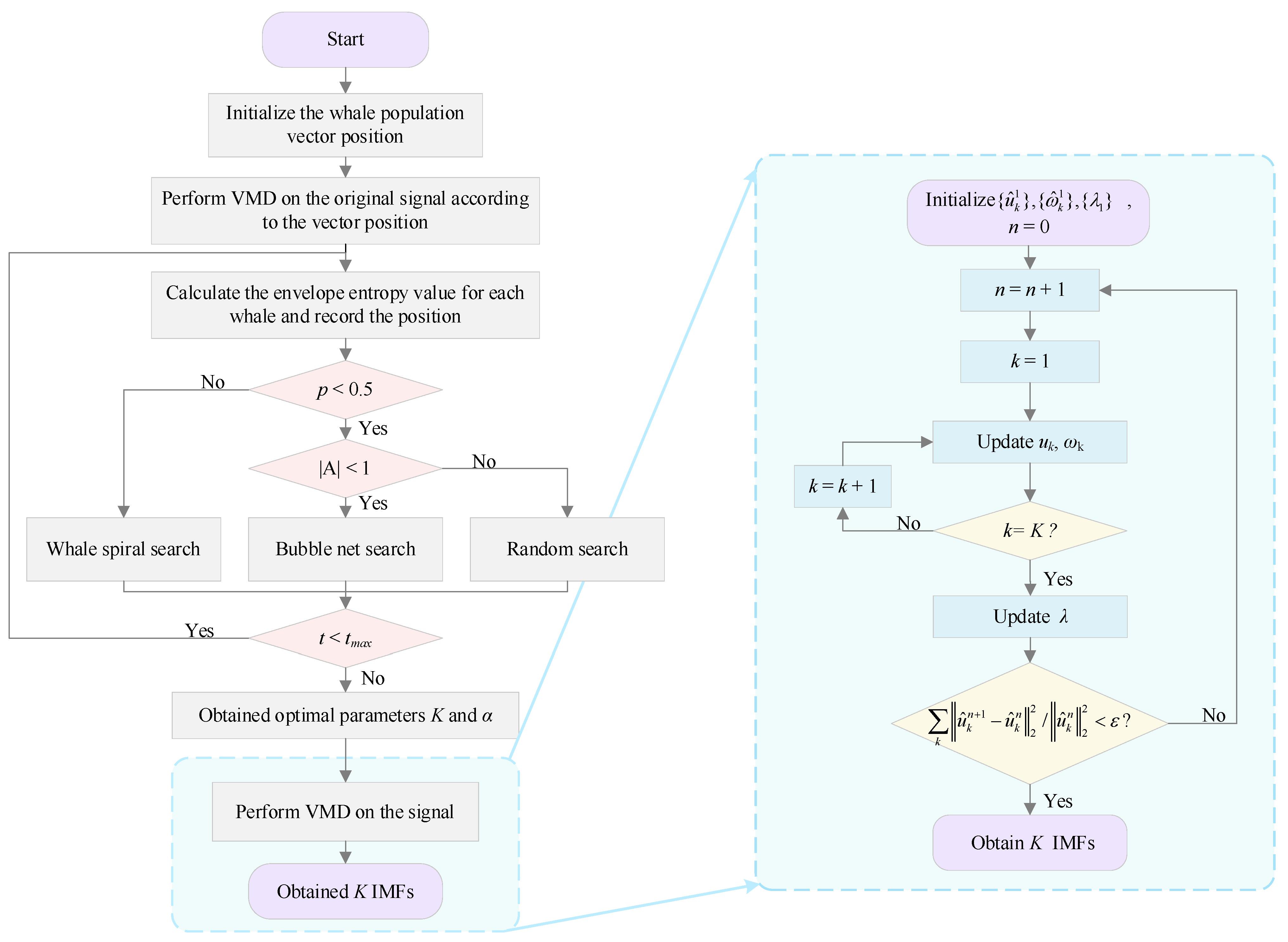
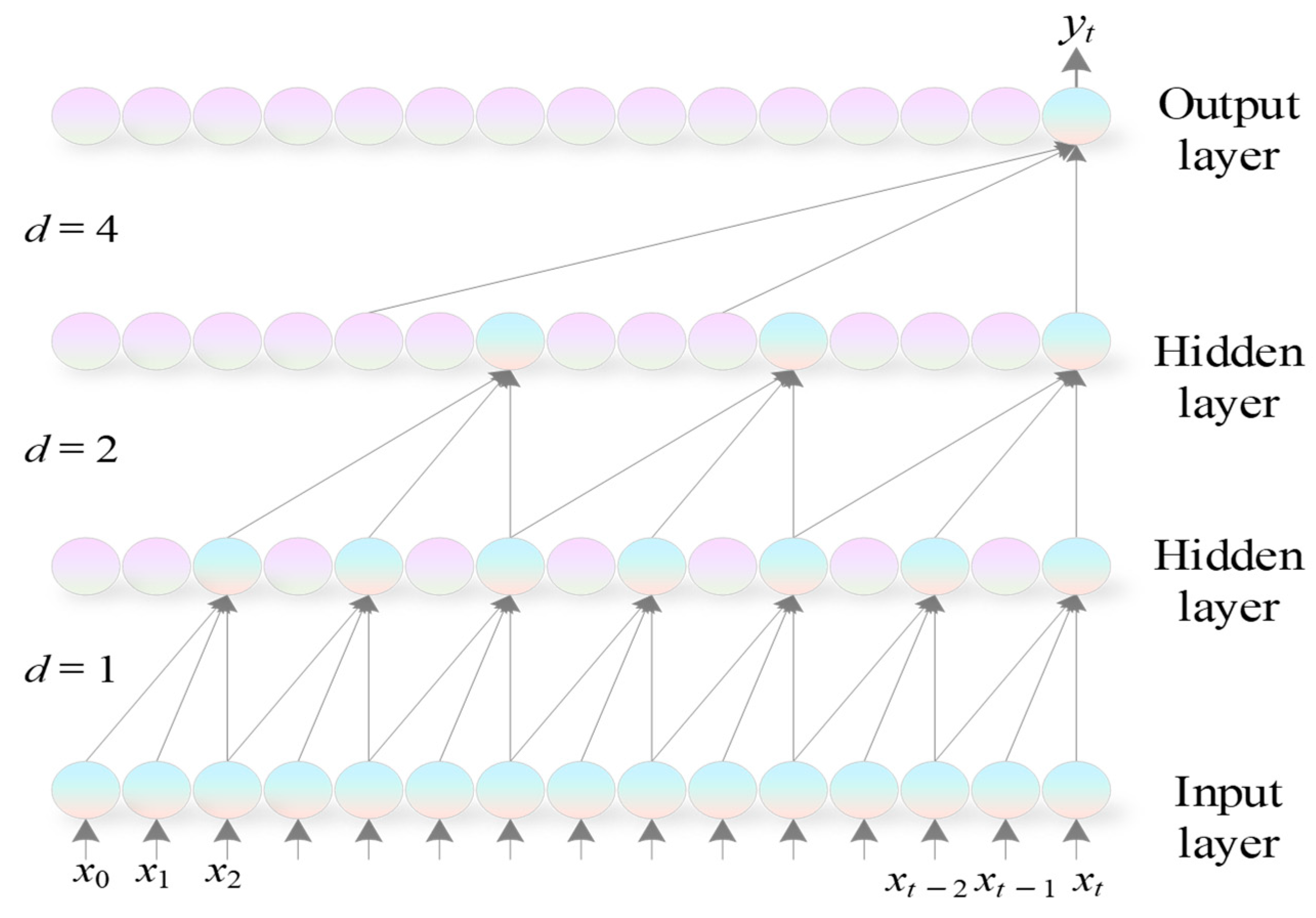

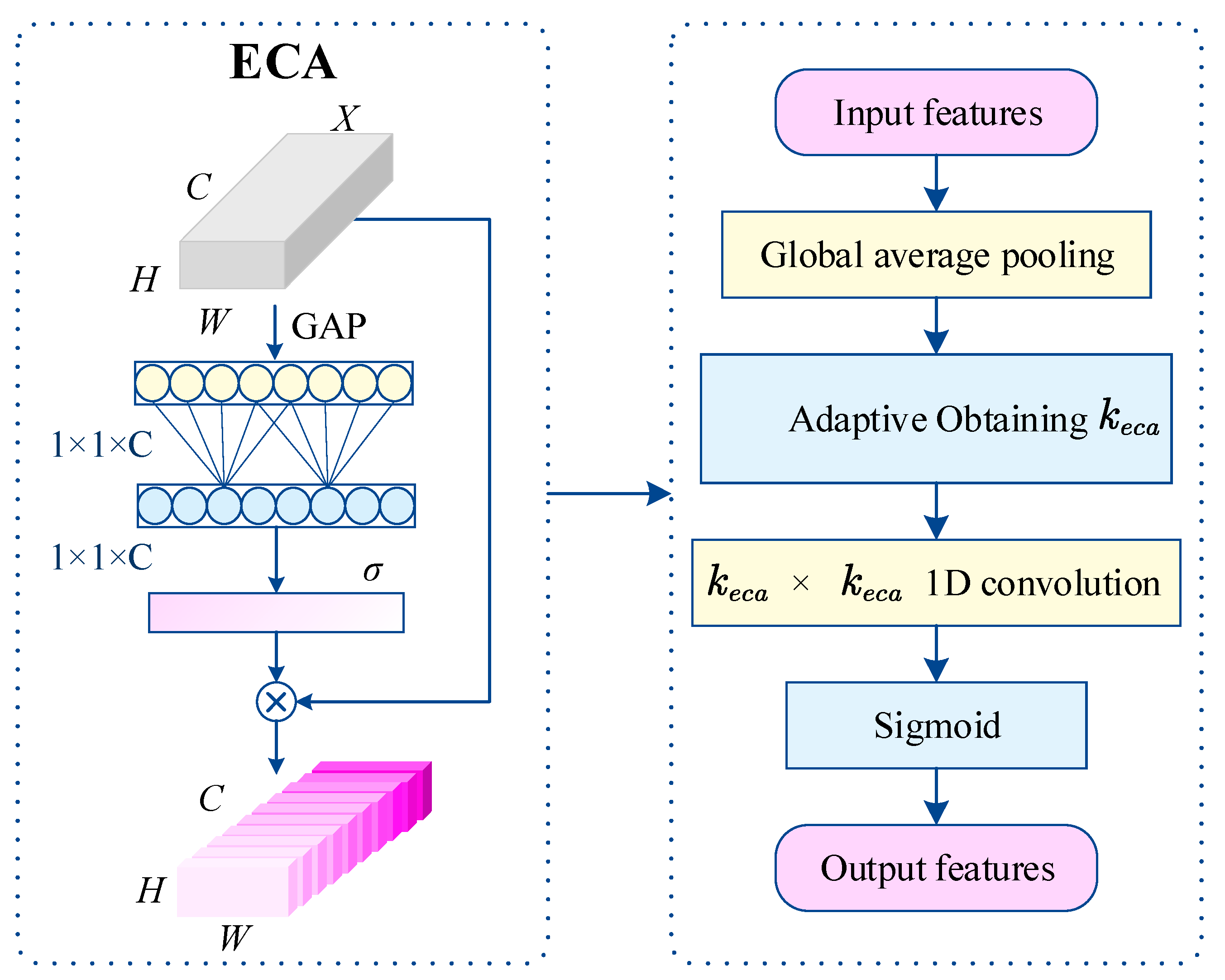



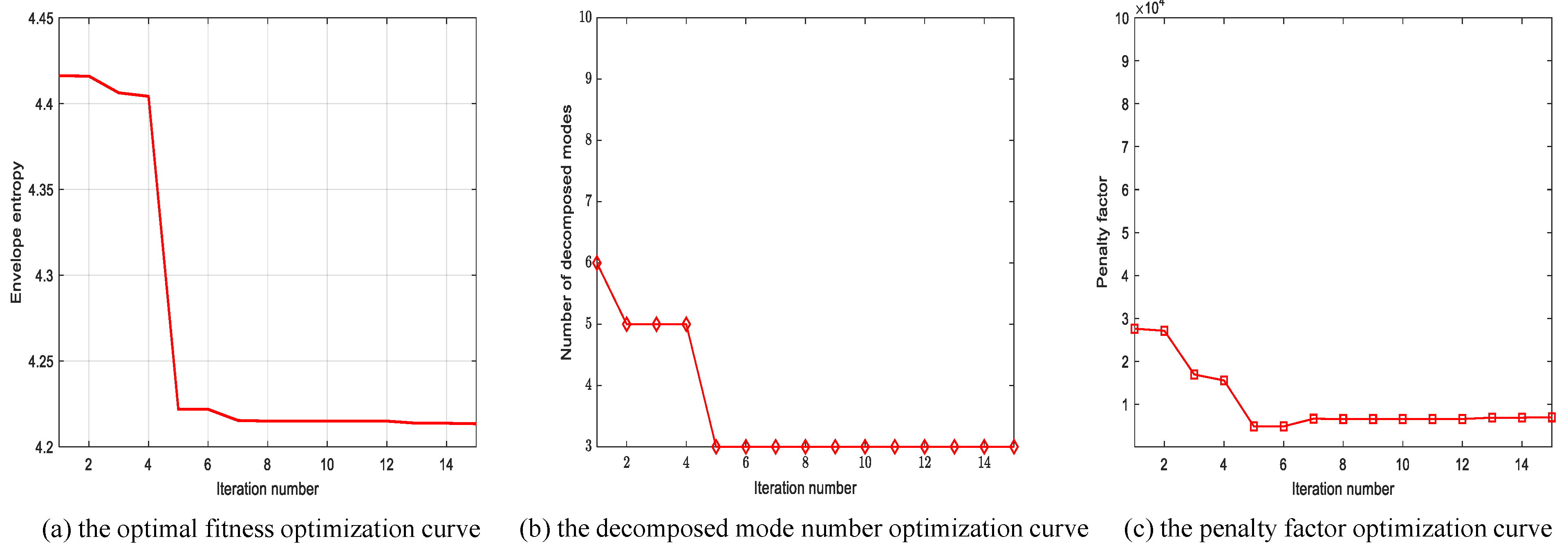


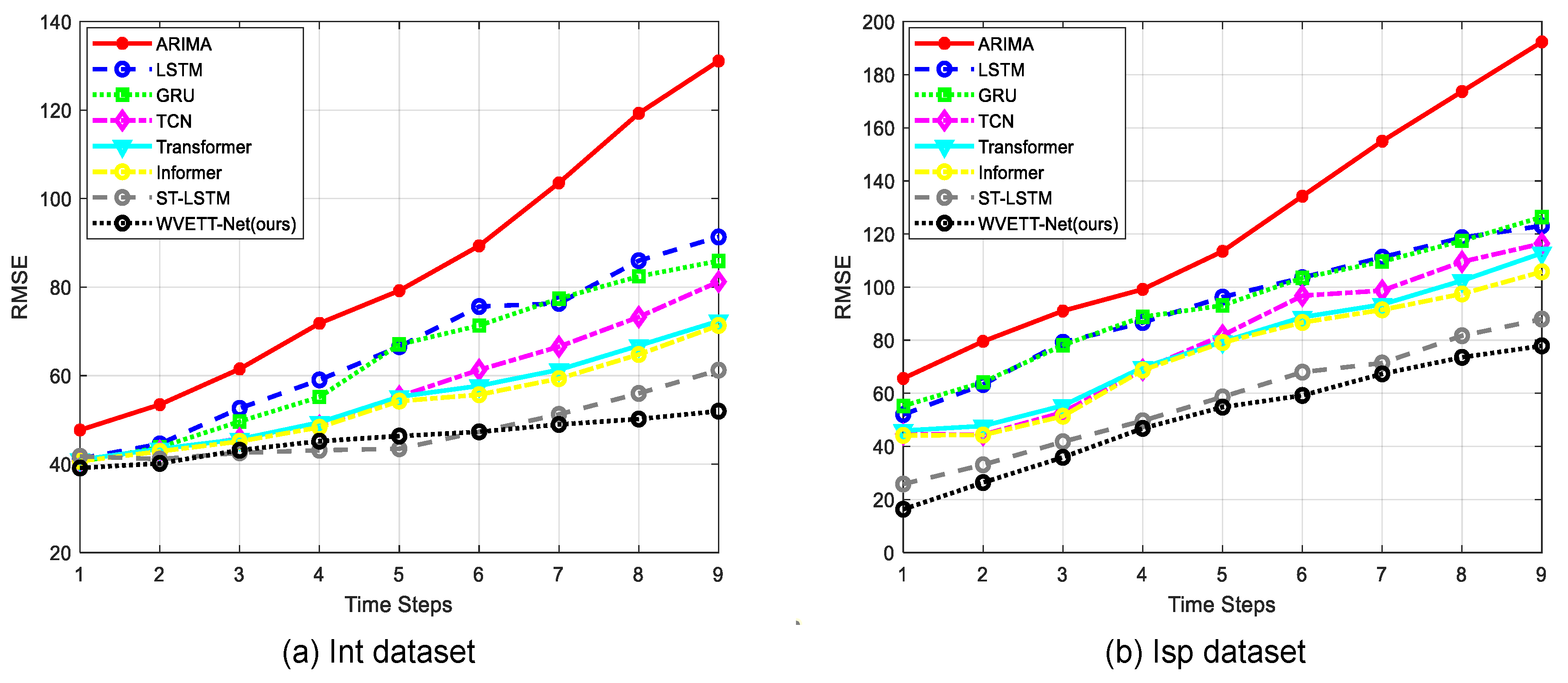
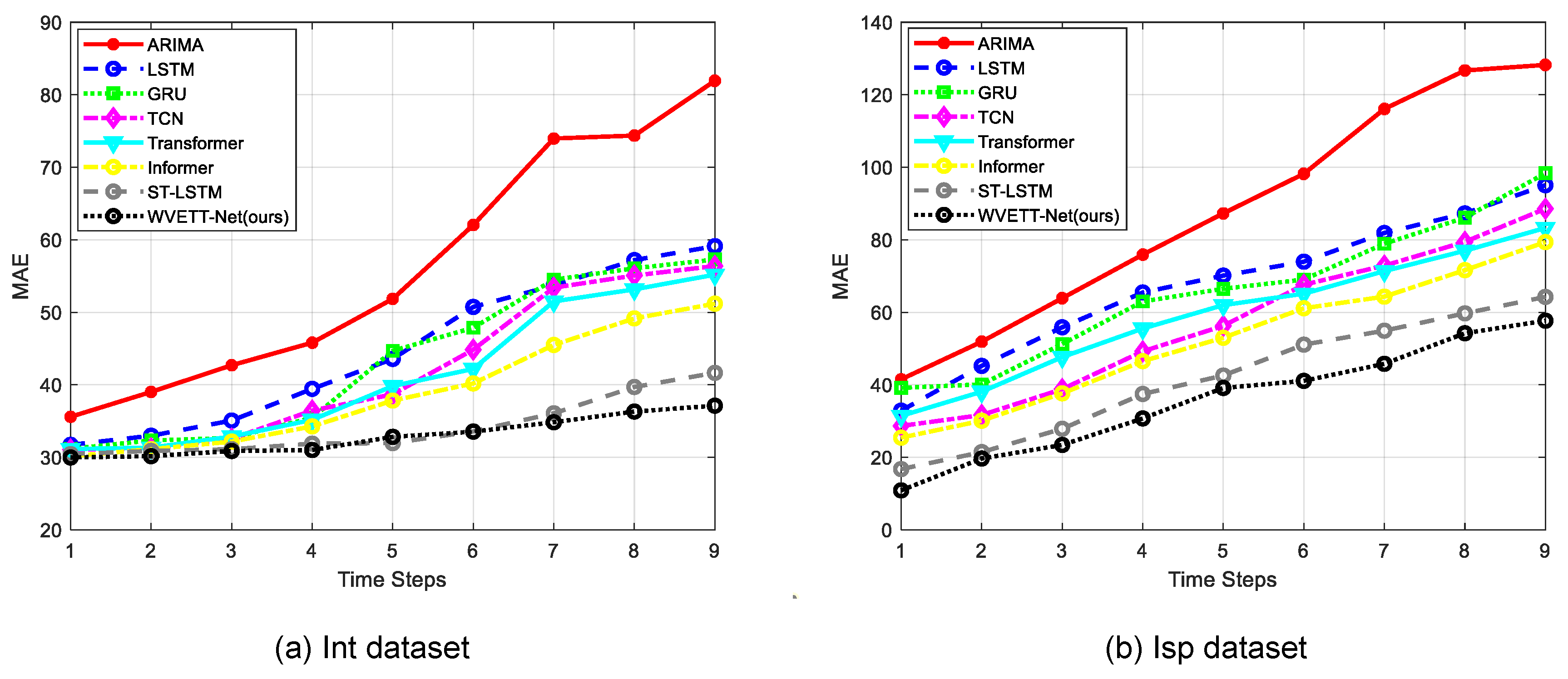

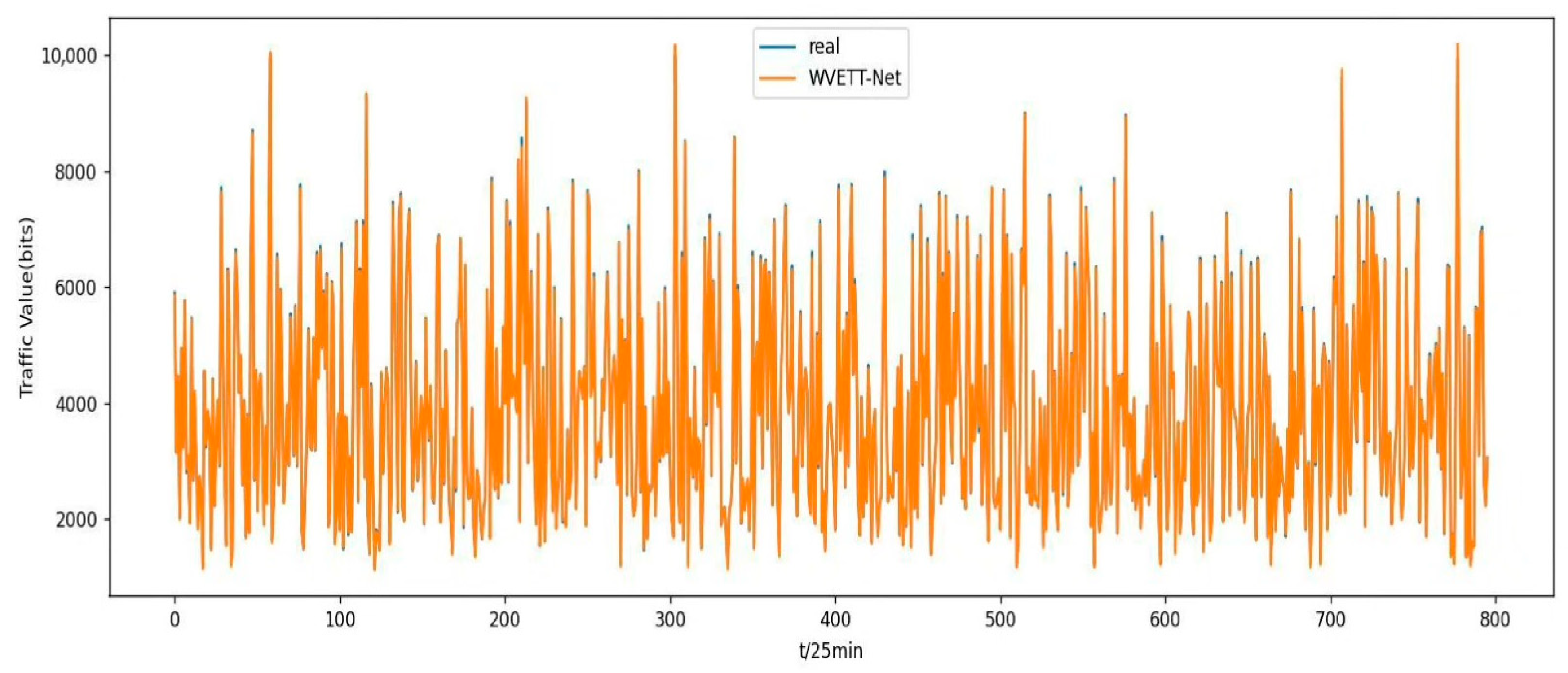



| Dataset | Model | Step 1 | Step 5 | Step 9 | ||||||
|---|---|---|---|---|---|---|---|---|---|---|
| RMSE | MAE | MAPE | RMSE | MAE | MAPE | RMSE | MAE | MAPE | ||
| ARIMA [6] | 47.69 | 35.59 | 0.81% | 79.20 | 51.85 | 2.25% | 131.09 | 81.93 | 3.15% | |
| LSTM [7] | 41.24 | 31.72 | 0.76% | 66.53 | 43.57 | 1.71% | 91.33 | 59.12 | 2.04% | |
| Int | GRU [7] | 40.53 | 31.17 | 0.73% | 67.04 | 44.69 | 1.79% | 85.92 | 57.28 | 1.97% |
| TCN [12] | 40.67 | 31.07 | 0.67% | 55.28 | 38.58 | 1.28% | 81.24 | 56.37 | 1.73% | |
| Transformer [13] | 40.99 | 31.15 | 0.71% | 55.23 | 39.83 | 1.25% | 72.33 | 55.19 | 1.66% | |
| Informer [14] | 40.64 | 30.15 | 0.65% | 54.23 | 37.75 | 1.22% | 71.35 | 51.21 | 1.63% | |
| ST-LSTM [11] | 41.77 | 30.44 | 0.54% | 43.47 | 31.96 | 1.09% | 61.23 | 41.65 | 1.28% | |
| WVETT-Net | 39.12 | 29.98 | 0.51% | 46.34 | 32.83 | 1.03% | 51.97 | 37.12 | 1.21% | |
| ARIMA [6] | 65.60 | 41.51 | 0.91% | 113.48 | 87.29 | 3.19% | 192.35 | 128.23 | 4.11% | |
| LSTM [7] | 51.97 | 32.87 | 0.77% | 96.24 | 70.12 | 2.27% | 123.07 | 95.06 | 3.09% | |
| Isp | GRU [7] | 55.26 | 39.16 | 0.79% | 93.10 | 66.49 | 2.19% | 126.42 | 98.37 | 2.98% |
| TCN [12] | 44.62 | 28.66 | 0.73% | 81.85 | 56.27 | 1.84% | 116.38 | 88.56 | 2.79% | |
| Transformer [13] | 45.94 | 31.43 | 0.76% | 79.42 | 61.98 | 1.87% | 112.79 | 83.27 | 2.66% | |
| Informer [14] | 44.15 | 25.43 | 0.71% | 79.13 | 52.94 | 1.85% | 105.83 | 79.36 | 2.59% | |
| ST-LSTM [11] | 25.83 | 16.75 | 0.69% | 58.64 | 42.56 | 1.38% | 87.95 | 64.25 | 2.26% | |
| WVETT-Net | 16.32 | 10.88 | 0.65% | 54.79 | 39.13 | 1.31% | 77.87 | 57.68 | 2.17% |
| Dataset | Model | Computation Time | |
|---|---|---|---|
| Train (s/Epoch) | Inference (s/Epoch) | ||
| WV-ST-LSTM | 18.7 | 1.2 | |
| Int | WVEHT-Net | 14.5 | 0.7 |
| WVETT-Net (ours) | 12.3 | 0.3 | |
| WV-ST-LSTM | 15.6 | 1.0 | |
| Isp | WVEHT-Net | 13.1 | 0.4 |
| WVETT-Net (ours) | 10.9 | 0.2 |
Disclaimer/Publisher’s Note: The statements, opinions and data contained in all publications are solely those of the individual author(s) and contributor(s) and not of MDPI and/or the editor(s). MDPI and/or the editor(s) disclaim responsibility for any injury to people or property resulting from any ideas, methods, instructions or products referred to in the content. |
© 2024 by the authors. Licensee MDPI, Basel, Switzerland. This article is an open access article distributed under the terms and conditions of the Creative Commons Attribution (CC BY) license (https://creativecommons.org/licenses/by/4.0/).
Share and Cite
Guo, J.; Tang, C.; Lu, J.; Zou, A.; Yang, W. WVETT-Net: A Novel Hybrid Prediction Model for Wireless Network Traffic Based on Variational Mode Decomposition. Electronics 2024, 13, 3109. https://doi.org/10.3390/electronics13163109
Guo J, Tang C, Lu J, Zou A, Yang W. WVETT-Net: A Novel Hybrid Prediction Model for Wireless Network Traffic Based on Variational Mode Decomposition. Electronics. 2024; 13(16):3109. https://doi.org/10.3390/electronics13163109
Chicago/Turabian StyleGuo, Jiayuan, Chaowei Tang, Jingwen Lu, Aobo Zou, and Wen Yang. 2024. "WVETT-Net: A Novel Hybrid Prediction Model for Wireless Network Traffic Based on Variational Mode Decomposition" Electronics 13, no. 16: 3109. https://doi.org/10.3390/electronics13163109
APA StyleGuo, J., Tang, C., Lu, J., Zou, A., & Yang, W. (2024). WVETT-Net: A Novel Hybrid Prediction Model for Wireless Network Traffic Based on Variational Mode Decomposition. Electronics, 13(16), 3109. https://doi.org/10.3390/electronics13163109





